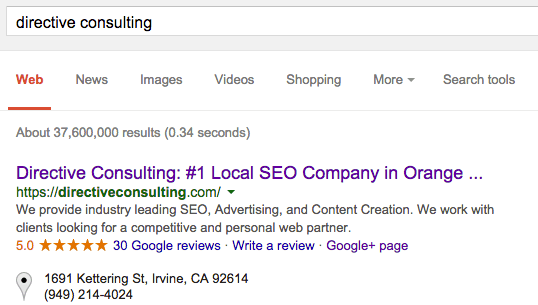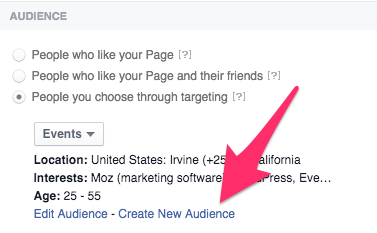
Local business owners and agencies alike struggle with understanding what truly moves the needle for local rankings.
We wrestle with the same issue. Because of that, we have constructed a five-day game plan for how a local business can triple impressions in a workweek.
Day 1: Get Reviews
A survey done by Brightlocal asked customers, “Do you read online customer reviews to determine whether a local business is a good business?” 88% responded that they have read reviews to determine the quality of a local business (vs. 85% in 2013).
Reviews are essential for local businesses, and with the local pack carrying more and more influence across queries (local or not), having reviews on your Google My Business page is essential.
Unfortunately, businesses so often settle to have reviews solely on their Yelp page. While Yelp is great, Google My Business and Facebook are also essential.
The following image is taken from Mike Blumenthal’s blog:

We know where we need reveiws, the question now, is how many? We have found that if you have 7 or more reviews on Google My Business, the stars will show up next to your name:

But the best answer to the “How many reviews do I need?” question is, “More (and better) than your competition!”
Despite the power of reviews, we have found that most people do not feel comfortable asking for reviews, forget to write them, or don’t know how. This email message can solve that. Simply copy and change:
Subject: Hey ___! We Have a Quick Favor.
Body:
Hi ____,
I have a quick favor. We are trying to get our reviews up on Google+.
Is there any chance you could leave us an awesome review? It’ll only take a few minutes and we’d really appreciate it.
If so, all you have to do is go on your computer and type “Directive Consulting” into Google and then click on “Write a review.”

It would be greatly appreciated, and I hope you have a great weekend!
(In case you were curious, we use a free tool called Skitch to mark up screenshots.)
Take a day to go through your clients, people who attended your events, and partners and get your reviews. Wait a month. After you have gotten your reviews for Google My Business, go back and get them for Yelp. Rinse and Repeat for Facebook as well.
Day 2: Keyword and Location
We all know that on-page optimization is important, but it can be difficult to understand how to optimize your business to rank locally. The ideal local page has your keyword plus your location in the following areas:
- URL (example: directiveconsulting.com/local-seo-orange-county-ca)
- Title (example: “Orange County’s Choice for Local SEO”)
- H1 (example: “It’s time the OC took a different approach on Local SEO”)
Notice that I didn’t use exact match keywords in each of the three areas. I did that to show that you do not need to sacrifice branding for keywords. Google’s algorithm is advanced enough to pick up semantic data, and their knowledge graph can correlate variations and nicknames for your area.
The keys for local on page optimizations are below:
- Each page only gets one keyword. Keyword stuffing is so 2004.
- Each landing page has a keyword and location in the URL, title, and H1.
- Talk about locally relevant content on your local pages. If you are a donut shop in San Juan Capistrano, CA, talk about the Swallow’s Day Parade and things that Google associates with your area. If you need help finding out what these are, look at the Wikipedia page for your city, and see what is associated with your town.
To begin optimizing your pages, go to your Google Webmaster Tools and analyze what queries are getting the most impressions. Then, prioritize the pages targeted towards these queries and optimize.
Day 3: Local Directories
Local directories send a massive signal to Google’s search engine. It lets them know that you are in the area that you say you are in.
The key when getting your local citations or directories is to be consistent. You need your Name, Address, Phone (NAP) to be consistent throughout. If you are not consistent with your NAP, you are sending Google mixed signals.
To prioritize your efforts, I have compiled a list of the top directories (in no particular order):
- Google My Business
- Yelp
- Foursquare
- Tripadvisor
- Superpages
- Infogroup
- YP
- Factual
- Best of the Web
- Citysearch
- Bing
- Yahoo
- Axciom
- DMOZ
- BBB
There is also a very large amount of directories that are industry-related. These are essential—make sure you are on these as well. In addition, here is a great post from BrightLocal that can help you identify citation opportunities that are specific to your city.
If you have gotten all of these and desire more, you can use Google’s search functions to identify more citation opportunities. Here is a compilation of over 1,000 query opportunities, and here are a few of my favorites:
- Keyword + “add a site”/”submit site”/”suggest site”/”post site”/”recommend site”
- Keyword + “add URL”/”submit URL”/”suggest URL”/”post URL”/”recommend URL”
- Keyword + “add listing”/”submit listing”/”suggest listing”/”post listing”/”recommend listing”
If doing this yourself seems like a daunting task, there are tools such as Moz Local, Yext, and BrightLocal that can take care of this for you.
Day 4: Partners!
Link building is not dead. I repeat: link building is not dead. In the local search landscape, there is no quicker way to impact organic rankings than to build relevant links.
This can be much more difficult than is commonly thought. One safe and easy way for local businesses to build links through relationships is a partners page. Here are the steps to achieve this link-building tactic and raise your domain authority.
Step 1: Take an inventory of your business partners: friends, distributors, wholesales, suppliers, chamber members, etc.
Step 2: Create a page with their logos on it, and add it to your footer. It doesn’t have to be all over your website and take away from your message. A simple link in the footer will do. Here is an example of the SEO giant’s Moz doing this very thing.

Step 3: Reach out to each person on your page, and ask if they will do the same for you. Explain that it will help them rank and be a good way to send referrals by simply referencing the link on their website. To make things easy, you can even offer to build the page for them.
While it seems basic, we have found that business owners understand and like this directory format and are willing to show off their partners in return for organic leads and referrals.
But why do links impact rankings so much, and why does a partners page work so well? The answer is quite simple: Google likes the popular kids. The way that Google knows you are popular is from how many websites are talking about you. They deem links the best way to know if people are talking about you. If you have lots of links, you must be popular. More popular means more traffic.
Furthermore, most partners are local to you. Thus, you are not only popular in Google’s eyes, but you are now also the hometown hero because all these websites in your area are linking to you.
Day 5: Write and Promote a Piece of Local Content
Locally relevant content rocks. This can be the most powerful form of local marketing for our clients. People love their area.
The goal for creating and promoting locally relevant content is to be the first thing people think of when searching for your product or service in the area. Here’s an example of how we could actually achieve this for a local coffee shop:
Step 1: Identify your audience. In the case of a coffee shop, it might be twentysomethings.
Step 2: What are they interested in? We need to identify our audience and their interests before writing. Never write and then promote. Understand how you can target and promote, then create. In the case of the twentysomething coffee enthusiasts, potential interest targeting might include local sports teams, local universities, craft beer, and other coffee shops in the area.
Step 3: Create the content. In this case, we might create a piece called, “The TwentySomething’s Guide to Nightlife in OC.”
Step 4: Promote it. Plug in your audience’s interests before boosting your post on Facebook. You can target an audience by clicking on “Create New Audience.” Then fill in your data and save before boosting your post.

If you are struggling to see how this can help with ranking, then understand that content should be viewed as a top of sales funnel marketing approach. As you create and promote content for audiences and not search engines, you will grow not only your organic and social traffic, but also your direct traffic.
If you are the first coffee shop that comes to someone’s mind when they are in the area, you will have a higher propensity to rank, provided you did your work from the first four days.
If you want to triple your impressions in a week, follow these tips over the next five days, and watch what happens. Keep earning links and creating locally relevant content for your audience, and the magic will happen.
Here’s that recipe one more time:
Reviews + Localized On-Page SEO + Citations + Local Links + Local Content = Local Rankings
Get more content like this, plus the very BEST marketing education, totally free. Get our Definitive email newsletter.

